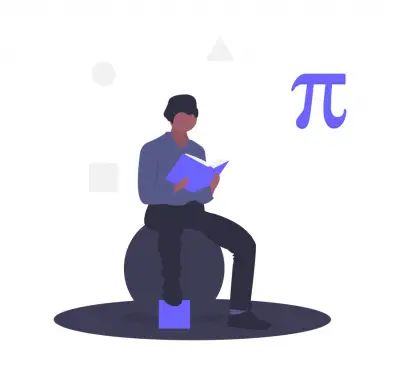
Further Mathematics Questions and Answers
Test your knowledge of advanced level mathematics with this aptitude test. This test comprises Further Maths questions and answers from past JAMB and WAEC examinations.

Test your knowledge of advanced level mathematics with this aptitude test. This test comprises Further Maths questions and answers from past JAMB and WAEC examinations.
3 sec
2 sec
4 sec
1 sec
Correct answer is A
\(u = 27 ms^{-1}; a = -9 ms^{-2}; v = 0; t = ?\)
\(v = u + at; t = \frac{v - u}{a}\)
\(t = \frac{0 - 27}{-9} = \frac{-27}{-9}\)
\(\therefore t = 3 sec\)
Given that M is the midpoint of T (2, 4) and Q (-8, 6), find the length of MQ .
\(√26 units\)
\(√28 units\)
\(√24 units\)
\(√30 units\)
Correct answer is A
\(|MQ| = \frac{1}{2} |TQ|\)
\(|TQ| = √((y2 - y1)^2 + (x2 - x1)^2)\)
\(|TQ| = √((6 - 4)^2 + (-8 - 2)^2)\)
\(|TQ| = √(2^2 + (-10)^2)\)
\(|TQ| = √(4 + 100) = √104\)
\(|TQ| = 2√26 units\)
\(|MQ| = \frac{1}{2} |TQ| = 2 \times 2√26\)
∴ \(|MQ| = √26 units\)
Find the radius of the circle \(2x^2 + 2y^2 - 4x + 5y + 1 = 0\)
\(\frac{\sqrt33}{4}\)
\(\frac{\sqrt5}{6}\)
\(\frac{5}{6}\)
\(\frac{33}{4}\)
Correct answer is A
Standard Form equation of a circle (Center-Radius Form): \((x − a)^2 + (y − b)^2 = r^2\)
Where "a" and "b" are the coordinates of the center and "r" is the radius of the circle
\(2x^2+2y^2-4x+5y+1=0\)
Divide through by 2
= \(x^2+y^2-2x+\frac{5}{2}y+\frac{1}{2}= 0\)
=\(x^2-2x+y^2+\frac{5}{ 2}y=-\frac{1}{ 2}\)
=\(x^2-2x+1^2+y^2+\frac{5}{ 2}y+(\frac{5}{ 4})^2-1-\frac{25}{16}=-\frac{1}{2}\)
=\((x-1)^2+(y+\frac{5}{4})^2=-\frac{1}{2}+1+\frac{25}{16}\)
=\((x-1)^2+(y-(-\frac{5}{4}))^2=\frac{33}{16}\)
=\((x-1)^2+(y-(-\frac{5}{4}))^2=(\frac{\sqrt33}{4})^2\)
\(\therefore a = 1, b = - \frac{5}{4} and\) \(r \frac{\sqrt33}{4} (answer)\)
The table shows the operation * on the set {x, y, z, w}.
| * | X | Y | Z | W |
| X | Y | Z | X | W |
| Y | Z | W | Y | X |
| Z | X | Y | Z | W |
| W | W | X | W | Z |
Find the identity of the element.
W
Y
Z
X
Correct answer is C
From the table, x * z = x, y * z = y, z * z = z and w * z = w
∴ z is the identity element
If\((\frac{1}{9})^{2x-1} = (\frac{1}{81})^{2-3x}\)find the value of x
\(-\frac{5}{8}\)
\(-\frac{3}{4}\)
\(\frac{3}{4}\)
\(-\frac{5}{8}\)
Correct answer is D
\((\frac{1}{9})^{2x-1} = (\frac{1}{81})^{2-3x}\)
\((\frac{1}{9})^{2x-1} = (\frac{1}{9})^{2(2-3x)}\)
\((\frac{1}{9})^{2x-1} = (\frac{1}{9})^{4-6x}\)
Since the bases are equal, powers can be equated
= 2x - 1 = 4 - 6x
= 2x + 6x = 4 + 1
= 8x = 5
\(\therefore x = \frac{5}{8}\)